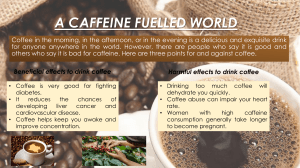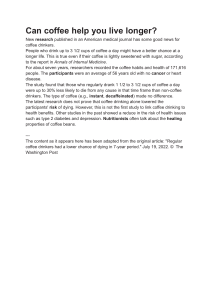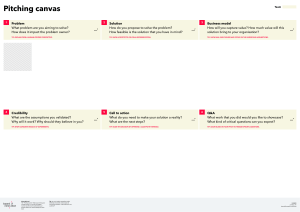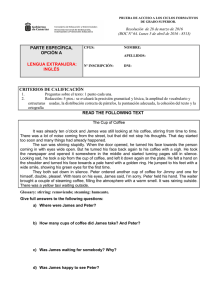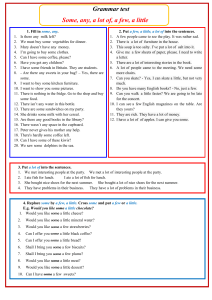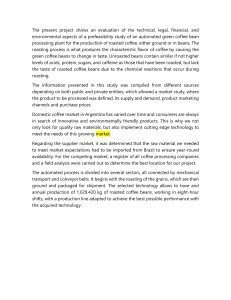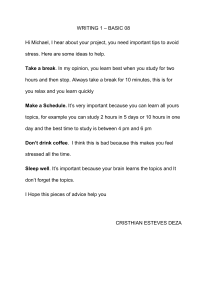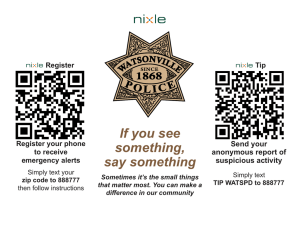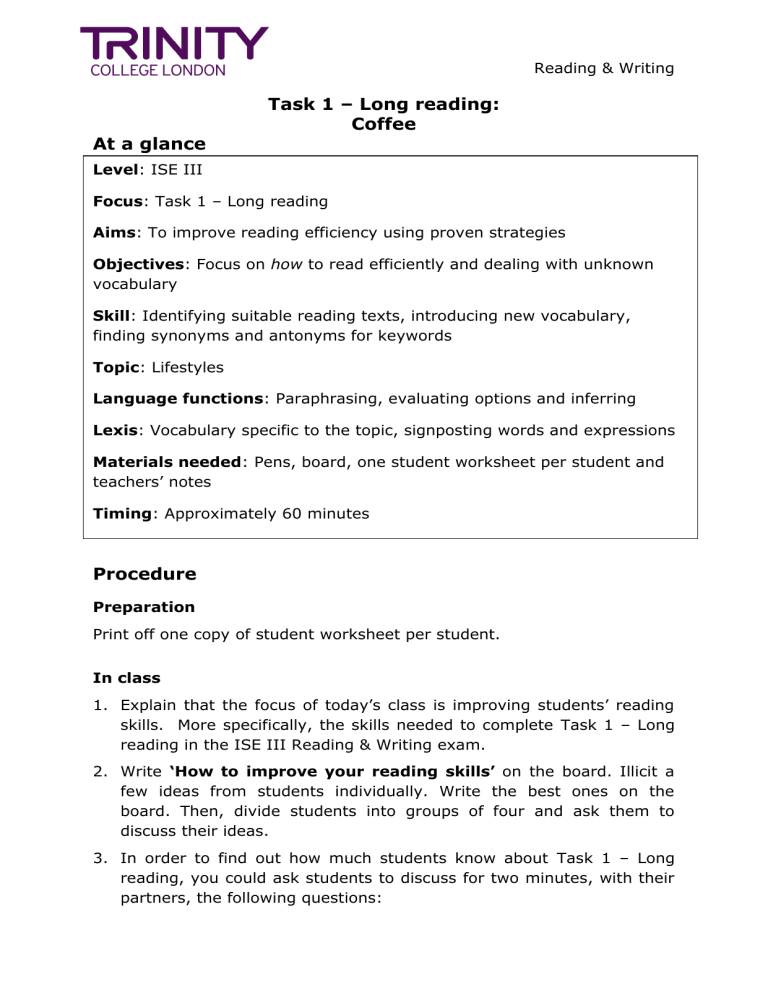
Reading & Writing Task 1 – Long reading: Coffee At a glance Level: ISE III Focus: Task 1 – Long reading Aims: To improve reading efficiency using proven strategies Objectives: Focus on how to read efficiently and dealing with unknown vocabulary Skill: Identifying suitable reading texts, introducing new vocabulary, finding synonyms and antonyms for keywords Topic: Lifestyles Language functions: Paraphrasing, evaluating options and inferring Lexis: Vocabulary specific to the topic, signposting words and expressions Materials needed: Pens, board, one student worksheet per student and teachers’ notes Timing: Approximately 60 minutes Procedure Preparation Print off one copy of student worksheet per student. In class 1. Explain that the focus of today’s class is improving students’ reading skills. More specifically, the skills needed to complete Task 1 – Long reading in the ISE III Reading & Writing exam. 2. Write ‘How to improve your reading skills’ on the board. Illicit a few ideas from students individually. Write the best ones on the board. Then, divide students into groups of four and ask them to discuss their ideas. 3. In order to find out how much students know about Task 1 – Long reading, you could ask students to discuss for two minutes, with their partners, the following questions: Reading & Writing How many questions will you need to answer for ISE III Task 1 – Long reading? (15). How much time will you have to complete Task 1? (20 minutes). Go through the answers in open-class. necessary. Write up the answers if 4. Give out one student worksheet per student. 5. Directing the students to Task 1 on the student worksheet, choose a student to read out Tip 1 and then the first question. Elicit a few examples. Then, divide students into pairs to answer a-d (allow approximately ten minutes). Re-group and go through their answers. Write some of their suggestions on the board. 6. Now ask the students to look at Task 2 which goes through different strategies for improving reading skills. Choose a student to read out Tip 1 and then ask students, in pairs, to discuss a-e. Give the students approximately ten minutes. Re-group and go through the answers. Write some of their suggestions on the board. 7. Choose a different student to read out Tip 2. Ask the students some questions about this point. For example: How often do you search for information in English on the internet? Have you thought about changing your language setting on your devices to English? Why/Why not? Ask students to work in groups of four to discuss e-g. Write the best answers on the board. 8. Ask another student to read out Tip 3. questions about this. For example: Ask the students a few How do you remember new words? How easy is it for you to remember them? What ways can you think of for improving this? Using their English books or some other material, ask them to work with a partner to answer the follow-up questions (approximately ten minutes). Bring the class together and go through their suggestions. Explain that how they deal with unknown vocabulary is a very important point in the exam. They will come across words which they don’t know, and they will have to guess their meaning. 9. Review the main points from the discussion and write down any useful information. Stress the importance of reading regularly and using the above techniques to improve their skill. 10. Now, explain to the class that they are going to work on an example of an ISE III Task 1 – Long reading. Explain that in some ways it Reading & Writing doesn’t matter what the subject of the text is, as they can use the following strategies each time. Firstly, using scanning techniques to find the gist of the text, then being able to cope with unknown vocabulary by either making an educated guess, or by inferring meaning from the context, also, by finding synonyms, or similar words in both the question and the passage, 11. Guide the students to look at Task 3, question 1. Tell the students that they will have three minutes to scan the passage and write down what the gist of the passage is. If necessary, demonstrate the speed of a scanner using your hand to slowly pass through the air. Go through some of the answers. Coffee needs to be part of the answer. Write down some of the best ones. 12. Remind the students that another important point for the Reading & Writing exam is being able to understand keywords, or being able to guess or infer meaning for them. Ask students in open class how they can do this, what strategies do they use, or are successful for them? 13. Ask students (individually), to spend ten minutes answering Task 3, question 2 which refers to some underlined keywords. Go through the answers. Tell them these particular words aren’t that important to know, the important point is that they develop strategies for dealing with unknown vocabulary. 14. Go through questions 3-5 (follow up questions) as a class. 15. Now explain to the class that there are other possible ISE III Task 1 – Long reading questions. Direct the students to Task 4. Tell students that one possible question is providing a suitable title for the text. Give students 1-2 minutes to come up with their own ideas and write down their title (Task 4, question 1). Go through some examples on the board. 16. Tell students that other questions which might appear in the test involve matching paragraphs to headings (Task 4, question 2). Explain that in order to do this, a useful strategy is finding words of similar meaning in both the passage and the headings. Go through the strategies as a class (A-G) (How much? Healthy heart etc). 17. Finally, explain that students may be asked to complete gap-fills using one word or a number. Ask them to cross-out the underlined words from the text and replace them with their own (except for hydrochloric acid for which there is no alternative). 18. Review the class by spending some time going through the different reading strategies they have learned about today in class and encouraging students to put them into practice whenever they can. Reading & Writing Extension activity More advanced students can continue to find synonyms/antonyms for more words in the passage. They could also be asked to provide a summary of the text. Further support activity Weaker students could work in pairs or small groups to complete the tasks. After class 1. From the reading passage, guess or infer the meaning of the words which you have underlined. Write down the meanings, how did you do this? 2. Find another short reading text (online or from your English books) and underline 10 unknown words. Use the strategies you have practised today to find the meaning. Reading & Writing Student Worksheet Task 1 – Long reading: Coffee Task 1 – What do you read? For the ISE III Task 1 – Long reading, you need to answer 15 questions based on a reading passage. You need to read quickly and effectively. Below are some suggestions to improve your reading skills. Tip 1: To improve your reading skills, you must read a lot. There are no easy solutions or secret recipes; you will only improve with time, dedication and practice. a. Talk to your partner about what you read in English. Write down three possible answers. b. Talk to your partner about what you could read in English. Write down three possible answers. c. Talk to your partner about what you’d like to read in English. Write down three possible answers. d. Ask your partner other questions about their reading habits: For example “when…why…how…what’s the...?” Reading & Writing Task 2 – Improving your reading skills Tip 1: Anything you read in English is good practice, so, firstly, read about subjects that interest you, then, move onto reading anything and everything. This will improve your vocabulary and your skills for dealing with unknown words and expressions. Also, most importantly, try to enjoy reading in English! The reading texts you find in the ISE III Reading & Writing exam are taken from a wide range, so you need to get used to reading all sorts of texts. Working with a partner, ask him/her: a. What subjects interest him/her b. Which subjects he/she is not interested in c. What he/she does when he/she comes across words or expressions in a reading passage which he/she doesn’t understand. d. With your partner, write a list of 10 different examples of reading texts, for example: newspapers, online blogs, etc. 1. 2. 3. 4. 5. 6. 7. 8. 9. 10. Reading & Writing Tip 2: As English is the most used language on the internet, whenever you search for information, try searching in English first. You could even change your default setting on your laptop, phone or tablets to English, so you are surrounded by English every day in your online world. Discuss search engines with your partner: e. Which ones has your partner used? f. Which ones does he/she believe are the best? g. Which are not good at all, and why? Tip 3: Remember that "understanding is not the same as using". Make a note of new words and phrases that you find when you're reading, and challenge yourself to using them in your own sentences that same day. Team up with a friend to do the same thing and see how you both improve. Practical suggestion: with a partner, find 5 words each which you don’t know and try to: Guess the meaning Look up the correct meaning in a dictionary Use the word in a sentence Reading & Writing Task 3 – ISE III Reading & Writing exam (Task 1 – Long reading) Exam type question The following is an example of the kind of text you may find in the ISE III Reading & Writing exam Task 1 – Long reading. ________________________________________ Around two thirds of the world’s population drink coffee, with an estimated 500 billion cups of coffee served worldwide every year. Around 180 million of us need a caffeine jolt to get us going in the morning. Most people enjoy their coffee and suffer no ill-effects through drinking it. There are, however, many potential dangers to drinking our drug of choice, particularly in terms of addiction and at certain times of the day. In small, occasional amounts there seem to be some advantages to drinking coffee. A raft of studies have shown that it can improve alertness and long term it may reduce the risk of developing Parkinson’s disease, gallstones, kidney stones and liver cirrhosis for heavy drinkers. Conversely, in the longer term it has been linked to an increased risk of high cholesterol, heart disease and osteoporosis. Another serious side effect of drinking coffee, particularly on an empty stomach, is that it stimulates hydrochrolic acid (HCI) production, this should only be produced to digest meals. So, if your body has to produce HCl more often in response to regular cups of coffee, it may struggle to produce enough to cope with a large meal. Another detrimental effect of drinking lots of coffee is that the stress hormones cortisol, epinephrine and norepinephrine are released which increase your body’s heart rate, blood pressure and tension levels. It is often said that drinking coffee gives us energy, but, for many of us, this has turned into a jittery kind of tension which makes it impossible for us to switch off. Reading & Writing Questions Scan the text quickly to find the gist of the passage. 1. What is the gist of the passage? 2. Now look at the underlined keywords and try to guess their meaning from the context i. Jolt ____________________________________________ ii. Potential ____________________________________________ iii. Raft ____________________________________________ iv. Conversely ____________________________________________ v. Hydrochrolic acid ____________________________________________ vi. Struggle ____________________________________________ vii. Detrimental _____________________________________________ viii. Jittery _____________________________________________ ix. Switch-off _____________________________________________ Discuss the answers with your teacher 3. Out of the 9 words, which did you guess correctly? How did you guess? 4. Find synonyms for the above words 5. Now write some possible antonyms for the above words It is really important to extend your vocabulary, so, whenever you can, take the opportunity to bring new words into your language, and USE them straight away before you forget them. Reading & Writing Task 4 – Other possible ISE III Task 1 – Long reading questions Provide a title 1. One question you may be asked on the ISE III reading test part one is to provide a suitable title for the passage. When you read the text quickly you understood the gist of the passage, this will help you when deciding on a suitable title. Now suggest a suitable title for the text ___________________________________________________ Matching paragraph titles 2. Another task involves matching titles of paragraphs. For this, a useful strategy is to find words of a similar meaning in both the passage and the headings: A How much? Tip: This can be found quite easily, as it probably relates to a number or price. Which numbers are mentioned in the text? ________________________________________________________ ___________ B Healthy heart Tip: There is much talk in the media about this at the moment. What is a “healthy heart” to you? ________________________________________________________ __________ C Elevated likelihood of developing serious heart consequences. Tip: There may be words you are unfamiliar with, use your powers of deduction to first of all decide if something is positive or negative, then fit the words together which you know, and try to formulate your own impression about what this means. Does it work in context? D An aid to digestion Tip: There are 2 parts to this – “an aid” is help, assistance, support; “digestion” – in the passage it says “to digest meals” – so you can make an educated guess about the meaning. Reading & Writing E Chemical factory Tip: The keyword here is Chemical so there is obviously a connection to chemistry, acid etc. F Constantly on the go Tip: Try to imagine what this means…”on the go” – action, non-stop, 24 hours. Constantly – all the time, every time. Sentence completion 3. Finally, you may be asked to complete sentences with one word, or a number. Delete the underlined keywords from the text and add your own, except for hydrochrolic acid. Reading & Writing Answer Key Task 2 D. Examples of reading texts include: magazine articles; reports; books; comics; cartoons; subtitles to films; adverts; subtitles to TV programmes; anything online in English; anything written in English when visiting an English speaking country; their English textbooks; emails to friends written in English etc. Task 3 1. What is the gist of the passage? Possible answers include: the negative effects of coffee; Coffee, how bad is it? Or, coffee, is it all bad 2. You can use a Thesaurus to check possible answers to keywords exercise. The following are some possible answers– i) Jolt – push, shock, start ii) Potential – possible, viable, arguable, feasible iii) Raft – range, sequence, various iv) Conversely- on the other hand, however, in contrast v) Hydrochloric acid- a strong acid used in many industrial and laboratory processes vi) Struggle – effort, exert, strain, force, pressure vii) Detrimental – negative, dangerous, damaging, harmful viii) Jittery – nervous, fluttery, shaky ix) Switch-off – relax, chillout, stop Task 4 1. A suitable title could be “The negative effects of coffee; the effects of drinking coffee; coffee- the pros and cons etc. 2. A – How much? – 500 billion, 180 million, B – Healthy heart – A heart free from disease; a heart which works well - when you run you are not so out of breath. D – A negative sense, due to the word consequences. Increased probability of advancing dangerous heart risks/effects/results/issues. 3. Some possible answers are included in number 2 above. Original Source http://www.businessinsider.com/facts-about-the-coffee-industry-201111?op=1&IR=T
